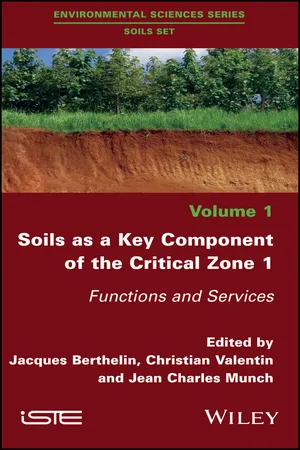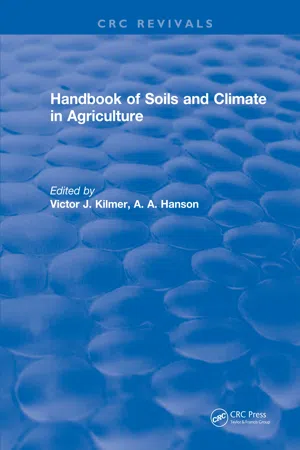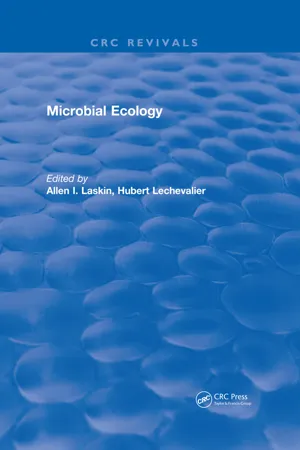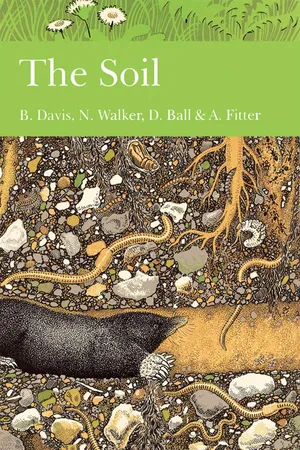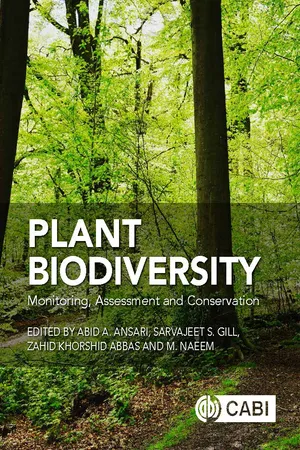Biological Sciences
Soil Microbiology
Soil microbiology is the study of microorganisms in soil and their interactions with the soil environment. It focuses on the diversity, functions, and roles of bacteria, fungi, protozoa, and other microorganisms in soil processes such as nutrient cycling, organic matter decomposition, and plant-microbe interactions. Understanding soil microbiology is essential for sustainable agriculture, environmental management, and ecosystem health.
Written by Perlego with AI-assistance
Related key terms
7 Key excerpts on "Soil Microbiology"
- eBook - ePub
Soils as a Key Component of the Critical Zone 1
Functions and Services
- Jacques Berthelin, Christian Valentin, Jean Charles Munch(Authors)
- 2018(Publication Date)
- Wiley-ISTE(Publisher)
Chapter 1 of this volume), form a major compartment of continental ecosystems, and they are the key component of the Critical Zone of human activities. They are open, interactive, four-dimensional (space-time) biosystems with five types of constituents; namely organic matter, mineral matter, water (solutions), gas (soil atmosphere) and living organisms (microorganisms, animals, plants) [GOB 10, BER 11]. Soils are biosystems [MUN 17] whose functions and services are determined by the dynamics and activity of living organisms and environmental parameters, whether they are natural or of anthropic origins. The richness of energy substrates and the structures in porous systems and aggregates guarantee the diversity and activity of organisms [BRU 17, MUN 17]. In addition, the organisms shape habitats in soils, which are favorable to their activity and their survival [DOM 70, HAT 73, STO 86, LAV 01, GOB 10, MAR 10, DEC 10, COL 15, MUN 17].This chapter is not exhaustive, but it emphasizes the richness of the communities of soil living organisms and their functional diversity. It underlines:- – the potential of this biological wealth;
- – the need to maintain and protect these soil properties and qualities;
- – the need to know and understand the organisms better, as well as their ecology, the conditions of their activities and the interactions between “organisms and environments” to better define, model and manage the soil–plant systems, and also in view of using it intensively for improving plant production.
5.2. Emergence and development of microbial ecology and soil biology
5.2.1. Discovery of the microbial world, a turning point in the knowledge of the functioning of soil–plant systemsIn the 1870s, chemists thought that they could solve the questions of plant nutrition like the origin of nitrates in soils, while Pasteur had already suggested a bacterial explanation (cited by Berthelin et al. [BER 06]). It was the work of Schloesing and Muntz between 1877 and 1879 that proved the role of microorganisms, and then that of Winogradsky, who, in 1890, isolated nitrifying bacteria [WIN 49].It was Winogradsky, on the one hand, and Beijerinck, on the other hand, who, by discovering the richness of the microbial world, initiated Soil Microbiology at the end of the 19th Century [BER 06]. First, it was developed for agronomic purposes before becoming microbial soil ecology. This discipline had (and still has) a major role in the emergence and development of biogeochemistry, geomicrobiology, phytopathology, biotechnologies and environmental engineering (water treatment, mineral and organic raw materials, waste) and in the definition of parameters to control the quality of water, air, etc. [BER 06, BER 07]. - eBook - ePub
- Victor J. Kilmer(Author)
- 2018(Publication Date)
- CRC Press(Publisher)
5Soil Microbiology
James M. Tiedje and Frank B. DazzoThe Soil Biota: its Composition, Density, and Biomass
The soil microbiota is comprised of five major groups: bacteria, actinomycetes, fungi, algae, and protozoa. Actinomycetes are a subgroup of bacteria but because of their prevalence in soil, their filamentous morphology, and their historical separation from bacteria by soil microbiologists, they are still commonly treated as a separate group. A sixth but nonliving biological group is the viruses which are also important in Soil Microbiology since bacterial, plant, and animal viruses are common in soil and can be of practical importance.Slightly larger organisms, the soil fauna, are also prevalent and important to plant litter decay in soils, although their density is greatly reduced in regularly cultivated soils. More noteworthy fauna include the nematodes, mites, springtails, and earthworms.Estimates of population densities and biomass of each of the biological groups have been made by several authors. Some are summarized in Table 1 . The methods of obtaining these data vary from generalized approximations based on experience to directly measured values obtained using the best methods available. Because of limitations of the methods and spatial variability of soil, data of this type are most useful for obtaining a general concept of the soil community, particularly which groups of organisms are expected to be dominant.Major advances in measurement of soil biomass have been made in the last decade, although it is still tedious work and often relatively imprecise. Difficulties exist in distinguishing between live and dead biomass and errors of extrapolation from a small sample to a large area basis. The current methods used to measure microbial biomass are summarized in Table 2 . They are based either on direct observation of cells or on measurement of a specific chemical entity. Counting live cells by plate counts or by most probable number (MPN) typically gives poor recoveries (1 to 10% or less) of the total biomass of interest, and is inappropriate for estimates of fungal biomass due to the great differences in spore production among genera. Thus the popular counting methods are direct counts of stained cells. The staining helps to distinguish cells from background and perhaps to distinguish live cells from some of the dead cells. The cell count is multiplied by the mean cell volume and by the biomass-to-biovolume conversion factor to obtain the biomass. VanVeen and Paul23 recently systematically measured the biovolume and conversion factors for representative soil bacteria, yeast, and fungi under different growth conditions. Their results (Table 3 - eBook - ePub
- Allen I. Laskin(Author)
- 2018(Publication Date)
- CRC Press(Publisher)
III. Methods of Studying Microbial Ecology in SoilThe variety of methods that have been used to study the activity, ecology, and population dynamics of microbes in soil reflects the complexity of this microbial habitat. Despite the multitude of methods, few, if any, have completely achieved their purpose, i.e., to study microbes in soil . Most methods either remove microbes from soil and study them in the laboratory or move soil to the laboratory and there study it for some function. No methods currently available begin to approach the level of the microhabitat, and, therefore, they only provide data which are some mathematical function of enumerable individual microhabitats. This is stated not to denigrate soil microbiologists but to emphasize the difficulties inherent in studying an environment as complex as soil and to underscore the ingenuity that soil microbiologists have demonstrated in their attempts to resolve these difficulties.Perhaps the greatest dereliction on the part of many investigators has been the tendency to extrapolate from relatively simple experiments – even though these may be well designed and employ extremely sophisticated instrumentation and techniques – to the in situ situation without verifying that the phenomena observed in vitro do occur, in essentially the same manner in vivo. Because the real purpose of microbial ecology is to determine what is occurring in the environment of interest – in this instance, soil – and not in the test tube, the investigator must shuttle continuously back and forth between model experimental designs and the in situ condition. Consequently, the soil microbial ecologist, perhaps more than any other microbial ecologist, must operate simultaneously on many levels of experimental complexity, ranging from natural field conditions to artificial pure culture systems and, where necessary, to the molecular level. In this multipronged approach, imagination, ingenuity, and the asking of critical questions are the key ingredients, and, although modern instrumentation can be an asset in many experiments, much can yet be learned by applying standard and relatively inexpensive methods to well-designed experiments. - eBook - ePub
- B. N. K. Davis, N. Walker, D. F. Ball, Alastair Fitter(Authors)
- 2013(Publication Date)
- Collins(Publisher)
CHAPTER 6 BACTERIA AND OTHER MICROORGANISMS OF THE SOILAll fertile soils harbour a vast range of microscopic organisms which include bacteria, micro-fungi, actinomycetes, yeasts, algae, myxomycetes, myxobacteria, protozoa and others, not to mention the large numbers of small soil animals. There is a bewildering array of species and genera, some of them present in great numbers, often many millions in a gram of soil. Soil, of course, is a particularly favourable habitat, with a variety of nutrients, for this world of microorganisms.Until about the middle of the seventeenth century, the realm of microorganisms was virtually unexplored. But at that time, in the town of Delft in Holland, Antony van Leeuwenhoek (1632– 1723) was busily engaged in grinding and polishing tiny glass lenses which he mounted and assembled into compound microscopes; with these somewhat primitive instruments, he became an enthusiastic observer of many kinds of natural microscopic phenomena. It seems likely that he was able to achieve magnifications of several hundred times and so was able to detect tiny, motile living creatures in, for example, drops of dirty canal water, infusions of pepper grains, scrapings from his teeth and other such preparations. Today, we realize that the tiny animalcules that he saw were indeed living motile bacteria. He reported many of his observations to the Royal Society of London, in a series of letters which are preserved in the Society’s Archives, but he was never willing to allow others access to his remarkable microscopes.Little more than a century ago, our knowledge of the multitude of microorganisms in soil or indeed elsewhere was almost negligible. Since then, however, especially during the last eighty years or so, impressive advances have been made in scientific microscopy, culminating in the astonishing transmission and scanning electron microscopes of today. These modern instruments can achieve very high magnifications, up to a hundred thousand times or more, and so make possible detailed observations of the fine structure of bacteria or even the much smaller virus particles and similar objects. - eBook - ePub
Microbes
Concepts and Applications
- Prakash S. Bisen, Mousumi Debnath, G. B. Prasad(Authors)
- 2012(Publication Date)
- Wiley-Blackwell(Publisher)
Chapter 6 Microbes in Agriculture6.1. Prologue
Microbes are the tiny living organisms not visible to naked eye. However, they play a very important role in Nature and contribute a lot to plants, animals, and human beings. In general, they represent the groups, prokaryotes and eukaryotes. Bacteria, actinomycetes, and blue-green algae are the sole representatives of prokaryotes. Among eukaryotes, algae, protozoa, and fungi are placed as microbes. Farmers and ranchers often think of microbes as pests that are destructive to their crops or animals (as well as themselves), but many microbes are beneficial. Soil microbes (bacteria and fungi) are essential for decomposing organic matter and recycling old plant material. Some bacteria and fungi form relationships with plant roots that provide important nutrients such as nitrogen and phosphorus. Fungi can colonize upper parts of plants and provide many benefits, including drought and heat tolerance and resistance to insects plant diseases.In agriculture, fungi, bacteria, algae, and viruses are important with respect to their contribution in the form of either loss or gain in the production of grains, fruits, vegetables, oil, milk, poultry, fodder, and livestock. Most of the nutrients, both minor and major, present in the soil are managed by microorganisms through integrated nutrient management. It has been observed that the efficiency of utilization of nutrients of high grade complex fertilizers in terms of biological chemicals and agronomic/economic efficiency has dropped from 20 to below 9 in terms of kg grain/kg of NPK. It is therefore important to manage the nutrients in a proper way.6.2. The Soil Plant Microorganisms
Microorganisms are known to be very important for plant growth. They multiply and actively help in making essential nutrients available for the plant through a symbiotic process by releasing the “locked-up” nutrients to be ready for uptake and utilization. Microorganisms have an active role in protecting plants against soilborne diseases (Fig. 6.1 - eBook - ePub
Plant Biodiversity
Monitoring, Assessment and Conservation
- Abid Ansari, Sarvajeet Singh Gill, Zahid Khorshid Abbas, M Naeem(Authors)
- 0(Publication Date)
- CABI(Publisher)
14 The Influence of Soil Microbes on Plant DiversityMOHAMMAD MOBIN *Department of Biology, Faculty of Science, University of Tabuk, Tabuk Saudi Arabia*E-mail: [email protected]AbstractThe ecological consequences of biodiversity loss have sparked a serious debate during recent times. However, significant advances have been made in exploring the relationship between plant diversity and ecosystem processes, unravelling the underlying mechanisms. Soil microbes have key roles in nutrient cycling, soil formation and plant interactions. These roles are vital to ecosystem processes and biodiversity. Therefore, this chapter aims to discuss the relation of soil microbes in determining biodiversity and ecosystem processes.14.1 Introduction
In recent times, one of the major challenges to the ecosystem is the disappearance of biodiversity. Ecosystem and biodiversity are strongly linked to each other where growing anthropogenic alteration of the ecosystem has slowly converted them into an almost defunct system. This unparalleled loss of biodiversity has created unease over the ramifications for the precise functioning of the ecosystem (Sala et al., 2000 ; Loreau et al., 2001 ; Jenkins, 2003 ; Millennium Ecosystem Assessment, 2005 ). As producers, plants assimilate mineral nutrients from inorganic sources that are mainly provided by decomposers, whereas decomposers (chiefly soil micro-organisms) take up carbon from organic resources that are delivered by autotrophic organisms. According to Naeem et al. (2000 ), ecosystem processes related to producer–consumer interactions are greatly disturbed by the loss of biodiversity. Plant-based organic resources infiltrate the soil via root exudation, rhizodeposition and leaf and root litters (Naeem et al., 2000 ; Wardle et al., 2004 ). In as much as the biochemical constituents of plant species vary greatly, alterations in plant diversity may affect these organic reserves both quantitatively and qualitatively. Consequently, the composition and metabolic functions of soil microbial communities are modified (Zak et al., 2003 ; Nilsson et al., 2008 - eBook - ePub
Soil Biochemistry
Volume 6: Volume 6
- J.-M. Bollag(Author)
- 2017(Publication Date)
- Routledge(Publisher)
In J. H. Slater, R. Whittenbury, and J. W. T. Wimpenny (eds.), Microbes in their natural environments, pp. 37-46. Society for General Microbiology, Symposium Vol. 34, Cambridge, U.K.253. Taylor, J., and R. J. Parkes, 1985. Identifying different populations of sulphate-reducing bacteria within marine sediment systems, using fatty biomarkers. J. Gen. Microbiol. 131:631-642.254. Grant, W. D., and A. W. West, 1984. Measurement of ergosterol, diaminopimelic acid and glucosamine in soil: evaluation as indicators of microbial biomass. J. Microbiol. Method. 6: 47-53.255. West, A. W., G. P. Sparling, and W. D. Grant, 1987. Relationship between mycelial and bacterial populations in stored, air-dried and glucose-amended arable and grassland soils. Soil Biol. Biochem. 19:599-605.256. Nakas, J. P., and D. A. Klein, 1981. Use of amino acid mixture to estimate the mineralization capacity of grassland soils. Soil Biol. Biochem. 13:427-428.257. Haanstra, L., and P. Doelman, 1984. Glutamic acid decomposition as a sensitive measure of heavy metal pollution in soil. Soil Biol. Biochem. 16:595-600.258. Alef, K., and D. Kleimer, 1986. Arginine ammonification, a simple method to estimate microbial activity potential in soils. Soil Biol. Biochem. 18:233-235.259. Kunc, F., and G. Stotzky, 1974. Effect of clay minerals on heterotrophic microbial activity in soil. Soil Sci. 118:186-195.260. Kunc, F., and G. Stotzky, 1977. Acceleration of aldehyde decomposition in soil by montmorillonite. Soil Sci. 124:167-172.261. Bewley, R. J. F., and G. Stotzky, 1984. Degradation of vanillin in soil-clay mixtures treated with simulated acid rain. Soil Sci. 137:415-417.262. Mathur, S. P., J. I. MacDougall, and M. McGrath, 1980. Levels of activities of some carbohydrases, protease, lipase and phosphatase in organic soils of differing copper content. Soil Sci. 129:376-385.263.
Learn about this page
Index pages curate the most relevant extracts from our library of academic textbooks. They’ve been created using an in-house natural language model (NLM), each adding context and meaning to key research topics.
